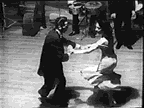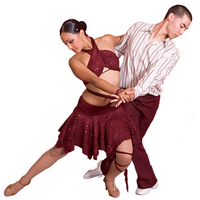
Home >> Music of the Caribbean >> Salsa
Salsa
Salsa History: The broad term Salsa refers to a variety of music with Cuban popular and folkloric roots, influenced by numerous cultural styles and characteristics. Formerly known simply as “Latin Music,” the name Salsa originated in New York City in the 1960’s when the record industry, in an attempt to publicize and sell Caribbean music in the United States, chose the Spanish word “sauce” to describe this new hip music. By the mid-1970’s the term had become increasingly well-known, as it was associated with the new music being produced by New York-based Latin musicians.1 It is important to note that despite its countless influences, Salsa emerged largely in part because of the advanced technology of recording studios in the New York music industry. Some argue that with its increasing popularity, Salsa became more of a business, losing its creativeness.2 Nonetheless, Indigenous, African, and European musical characteristics are all highly influential in contributing to the basis of Salsa music. Resulting from the Spanish colonization of the Caribbean in the 16th century, Caribbean music began using a plethora of stylistic elements including an intricate blend of musical styles and rhythms, instruments, and an array of dance steps, all of which were essential to the foundation of the music.3 While maintaining key fundamental aspects of its origins, Salsa continues to evolve today. The music undergoes unique transformations as it comes into contact with other musical genres, constantly shaping the various popular trends and styles of music in today’s society.
Salsa Origins & Influences: Son, dating from the early 1900’s, is arguably the most influential component of modern-day Salsa music. It is also responsible for generating numerous significant styles in the Caribbean. Son is a unique combination of various components deriving from several ethnicities, such as Spanish guitar songs, African rhythms, and a variety of percussion instruments. Upon arriving in New York City, Son was further influenced by the city’s own music styles and it significantly contributed to the development of Salsa music.4 Danza/Danzón, inspired by the European Colonists- specifically the French contredanse- is one particular form of dance music in the Caribbean that is essential to Caribbean music. 5 This popular style became increasingly fashionable on a global scale, providing the world with original dance rhythms. “La Borinqueña,” Puerto Rico’s anthem is an example of a Danza. This style of dance music is a vital aspect contributing to the creation of Salsa music.6
Influences African Influences: The emphasis of drumming in Salsa music is crucial. African slaves brought to the area impacted the development of Salsa with traditional drumming. Also present in Salsa music is the call-and-response singing. This style derived from Africans who were known to form and emphasize the relationship between music and language. Particularly executed by drums, the Africans created the “talking drums,” which certainly inspired a component of Salsa music. Perhaps the most important influence is the correlation between music and dancing. Salsa is the major aspect of Latin dance music and there is certainly a connection seen between African and Latin dance steps.7 European Influences: Due to its important role in colonizing the Caribbean area, Spain’s music, more than any European country, had the largest impact on Latin music. By the 16th century Spain’s music had already undergone several transformations, evolving with the many preceding ethnical influences. With its classical music traditions, both the Roman Catholic Church and the Spanish court captivated the inner-city Caribbean music. The folk-style music of Spain, country folk songs and dances in particular, served as inspiration to the rural music of the Caribbean. A central aspect in the makeup of the Caribbean culture was the combining influences of both Spanish and African dances.8 Salsa Instruments: Salsa encompasses a variety of instruments in order to give it that hot unique touch. The typical Salsa instruments derive from a modification of son conjunto, a musical ensemble.
Further Readings:
|


